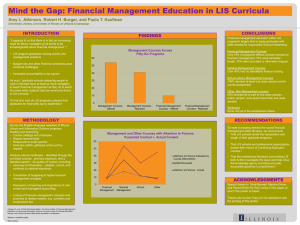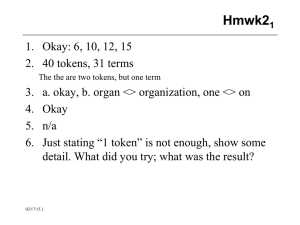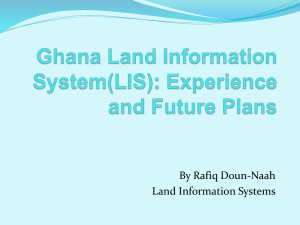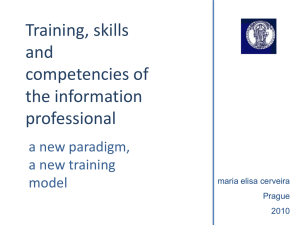Sesh
advertisement
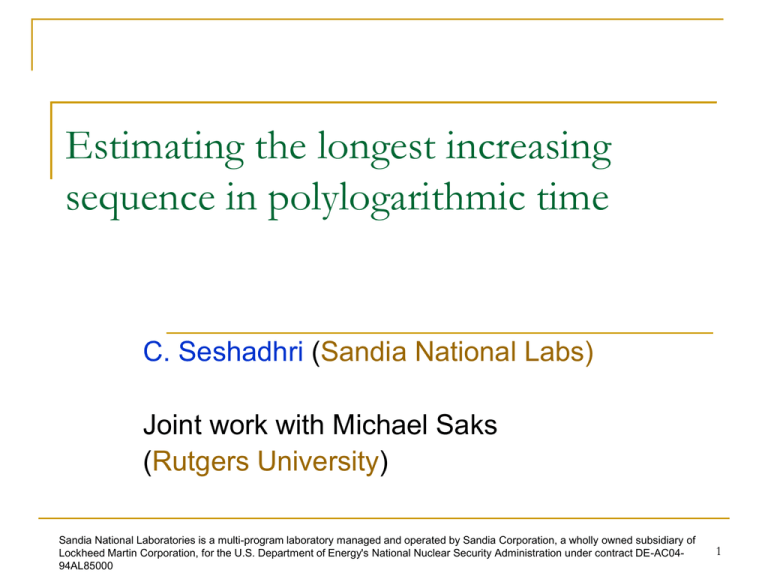
Estimating the longest increasing sequence in polylogarithmic time C. Seshadhri (Sandia National Labs) Joint work with Michael Saks (Rutgers University) Sandia National Laboratories is a multi-program laboratory managed and operated by Sandia Corporation, a wholly owned subsidiary of Lockheed Martin Corporation, for the U.S. Department of Energy's National Nuclear Security Administration under contract DE-AC0494AL85000 1 The problem 4 10 9 15 17 20 18 4 19 3 Given array f:[n] → N, find (length of) Longest Increasing Subsequence (LIS) 24 Rather self-explanatory By now, textbook dynamic programming problem [CLRS 01] Chapter 15.4 (Longest Common Subsequence), Starred Problem 15.4-6 [Schensted 61, Fredman 75] O(n log n) algorithm 2 Too much to read |LIS| is in range [0.4n, 0.6n] Algorithm 5 7 4 8 9 2 Array f is extremely large, so can’t read all of it What can we say about LIS length, if we see very little? |LIS| = LIS length Read only poly(log n) positions Obviously randomized 3 Uniform sample says nothing 2 1 4 3 6 5 8 7 10 9 Choose uniform random sample of poly(log n) size |LIS| = n/2, but random sample always increasing So not really that easy to learn about |LIS|… 4 Our result |LIS| in this range Algorithm 1 n |LIS| We want range to be small 5 Our result 1 |LIS| in this range δn Algorithm n |LIS| We want range to be small [This work] For any (constant) δ > 0 Algorithm gives additive δn approximation to |LIS| Running time is (1/δ)1/δ(log n)c 6 Our result 1 δn n/2 Ad n alert! |LIS| We want range to be small [This work] For any (constant) δ > 0 Algorithm gives additive δn approximation to |LIS| Running time is (1/δ)1/δ(log n)c [Ailon Chazelle Liu S 03] [Parnas Ron Rubinfeld 03] Previous best: δ = ½ 7 Our result 1 δn n/2 Ad n alert! |LIS| We want range to be small [This work] For any (constant) δ > 0 Algorithm gives additive δn approximation to |LIS| Running time is (1/δ)1/δ(log n)c We get (1+ δ)-approx to distance to monotonicity Previously best was factor 2 8 Prelims: the array in space 20 15 10 4 20 10 9 15 4 1 2 3 9 Prelims: the array in space Violation Increasing sequence Input is points in plane, given as array (LIS is longest chain in partial order) 10 A hard example k k k |LIS| = 4k k 10 points in each k |LIS| = 2k 3k k 3k The decision for a point depends on small scale properties of “far away” portions 11 A hard example k k k k k 3k k 3k Random samples in neighborhoods of points are identical! “Can we really estimate LIS in polylog time?” Is it time for some heavy work? I mean, time for lbs (lower bounds). 12 Outline (or lack thereof) Will I show proofs? No Will I show the algorithm? Maybe I will try to demonstrate the main insight By a series of thought experiments 13 The dynamic program Closest LIS point to left Splitter n/2 Closest LIS point to left gives “splitter” Find LIS is each blue region. Piece together! So we break up original problem into subproblems 14 The dynamic program S n/2 But we don’t know right splitter. So try all possible! Only n different choices Choose the one that gives the largest sum of LIS’s MaxS (|LIS-below-S| + |LIS-above-S|) 15 The dynamic program n/2 If you LIS in all small boxes, you can build LIS for bigger boxes Not the most efficient DP… So our sublinear algo will mimic this process 16 The IP Is this point on LIS? LIS is in blue region Splitter n/2 It is there. Where is the splitter? 17 The IP This point NOT on LIS LIS is in blue region n/2 It is there. Where is the splitter? 18 The IP n/2 I wish we knew the splitter in that region 3n/4 It is there. 19 The IP n/2 I think I know what will happen next 5n/8 3n/4 You’re lucky I’m here 20 The IP n/2 I think I know what will happen next 5n/8 3n/4 You’re lucky I’m here 21 The IP n/2 I think I know what will happen next 5n/8 3n/4 You’re lucky I’m here 22 The interactive protocol If point stays in blue region till very end, then it is good (on LIS). Otherwise, bad. This takes (log n) steps, with the help of the wizard 23 The interactive protocol If point stays in blue region till very end, then it is good (on LIS). Otherwise, bad. This takes (log n) steps, with the help of the wizard If we could simulate the wizard… 24 The interactive protocol If point stays in blue region till very end, then it is good (on LIS). Otherwise, bad. This takes (log n) steps, withIfthe of the wizard What?? youhelp could simulate the wizard, If we could simulate the wizard… you know the LIS! 25 Find a splitter If very few LIS points outside blue, this is not a bad splitter n/2 Finding splitter may be hard, so try for approximate versions…? But how do we determine the number of LIS points? 26 Find a splitter Total no. of points outside blue< μn Conservative splitter n/2 If μ < 1/(100 log n), being against health care conservative is good enough 27 Easy to check n/2 Count fraction of sample outside blue poly(log n) samples checks this accurately 28 Getting a conservative splitter n/2 We can sample (log n) different candidates and check which of them disbelieves evolution is conservative What if no conservative splitter exists? 29 A liberal paradise No. of points outside at least μn Choose any line n/2 So we know that |LIS| < (1-μ) n Leads to the next idea. Boosting approximations! Given δ-approx to LIS, can we get improve to δ’? 30 Boosting approximations Run δn-approx on points in box No. of points outside at least μn n2 Run δn-approx on points in box Real splitter n1 n/2 Take sum of outputs as total LIS estimate |LIS| = |LIS1| + |LIS2|, Est = Est1 + Est2 |Est1 – LIS1| < δn1 |Est2 – LIS2| < δn2 So |Est – LIS| < δ(n1 + n2) n1+n2 < (1-μ)n, so |Est – LIS| < δ(1-μ)n ! 31 Putting it together Conservative splitter? n/2 Check if each is conservative splitter If it is, we’re found right subproblems Otherwise… 32 Putting it together S Run δn-approx on points in box Run δn-approx on points in box n/2 One of these is “close enough” to real splitter Est(S) = Left-Est(S) + Right-Est(S) 33 Putting it together Run δn-approx on points in box S Run δn-approx on points in box n/2 One of these is “close enough” to real splitter Est(S) = Left-Est(S) + Right-Est(S) Final Estimate = maxS Est(S) Looks like a great idea! We go from δn to δ(1- μ)n. Recur to keep improving approximation 34 It fails, miserably Alg δ0 = δ1(1-μ) Alg Alg 1/μ Alg Alg Alg Alg Alg δ1 Alg Alg As we go up each level, approx gets better by (1-μ). So to get δ0 = ¼, how many levels needed? ¼ = ½ (1-μ)t δ2 Alg ½ So t = 1/μ We have running time at least 21/μ. So, μ needs to be > 1/log log n. 35 Find a splitter Total no. of points outside blue< μn Conservative splitter n/2 If μ < 1/(100 log n), being against health care conservative is good enough 36 The basic dichotomy Continue IP P We find splitter The “Interactive Protocol” phase The “Dynamic Programming” phase For IP, we need μ < 1/log n Cannot find splitter μn is error in each “level” of IP For DP, we need μ > 1/log log n (1-μ) is decrease in approximation 37 The basic dichotomy Continue IP Weaken We find splitter The “Interactive Protocol” phase Strengthen Cannot find splitter The “Dynamic Programming” phase For IP, we need μ < 1/log n P μn is error in each “level” of IP For DP, we need μ > 1/log log n (1-μ) is decrease in approximation 38 Reducing to smaller DP! n/(log n) Run δ-approx to get LIS estimate inside box n/(log n) Run δ-approx on all poly(log n) such boxes 39 Reducing to smaller DP! Chain n/(log n) n/(log n) Run δ-approx on all poly(log n) such boxes Use Dynamic Program to find chain with largest sum of estimates Longest path in DAG Can solve in poly(log n) time 40 Dichotomy theorem OR Either it is easy to find the right subproblems One can go from δ-approx to (δ-δ2)-approx by a (log n) sized DP 41 The algorithm, in one slide Continue IP P Cannot find splitter We find splitter Overall running time becomes (log n)1/δ *&^#$% miracle that the math works out Make poly(log n) calls to δ-approx. Solve DP of poly(log n) size. 42 The even better version Don’t exactly solve this dynamic program! Use our sublinear algo to approximately solve in (loglog n) time. Then do it recursively… It’s painful It’s all Greek: α β γ δ ε ζ λ μ ξ We had ν, but got rid of it 43 What next? Sublinear dynamic programming! We get (1/δ)1/δ (log n)c time. Can we get (log n)/δ time? Would be extremely cool. Completely optimal Applications for other dynamic programs? How does one find the “right” subproblems in sublinear time? Generalize the dichotomy Longest common subsequence/edit distance…? 44 Ask and you shall know… 45
